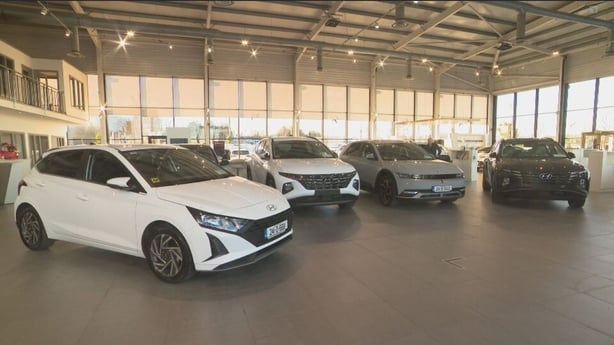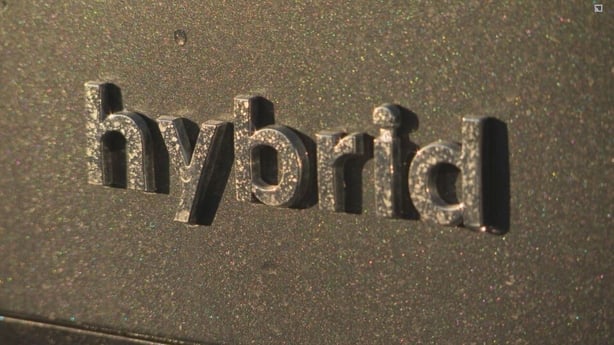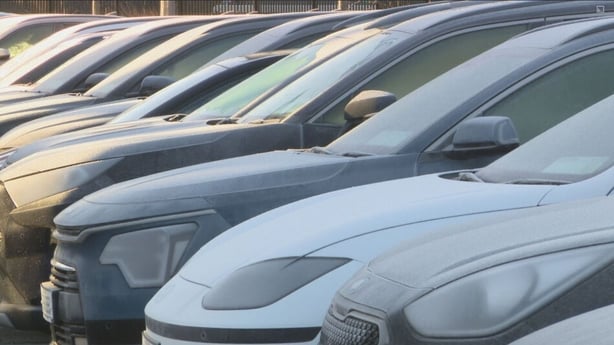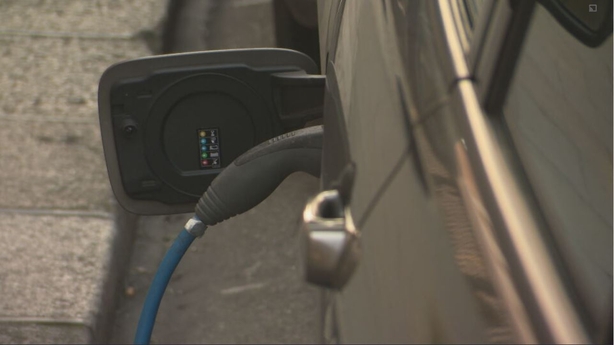The cold weather wasn't slowing the pace of work at Hutton and Meade’s car showrooms in Ballycoolin this week.
January is the busiest month of the year in the car trade and at the north-west Dublin showrooms, the 42 staff employed by the business were busy prepping new vehicles for buyers.
The 2.7 acre site is stuffed with vehicles – new and used - as the New Year selling season ramps up.
For managing director, Joe Hutton, the hope is that this year will be as good as the last when it comes to deal-making.
"2023 was a very good year," he explains, surrounded by a range of gleaming cars on the showroom floor.
"It was very good on the previous years. We are after getting through Covid and whatever, so 2023 was very positive."

Its true to say that the motor trade in Ireland, and by extension its customers, have been through a tricky few years.
First Brexit threw a spanner in the engine, creating huge difficulties in the used car market, as the torrent of UK imports dropped to a trickle.
Then came the pandemic and with it economic concerns coupled with supply chain issues, which meant many people couldn’t afford to change cars and those that could often couldn’t get them.
On top of that, the changing interest rate environment of recent years has put the cost of car finance up.
Add to that the general cost of living squeeze and inflation and it made for challenging conditions for dealers.
But 2023 did end up delivering for the trade.
New car sales rose by 16,075 or 16% compared to 2022, while used car sales increased by 8% to 50,381.
"We are now actually back to pre-Covid sales level, in fact we did a little bit better than 2019," said Brian Cooke, Director General of the Society of the Irish Motor Industry.
"We would like to get back to pre-Brexit vote levels, but at the same time I think it was a step forward."
2023 was not only defined by a recovery in new car sales generally. It was also a year in which electric vehicle (EV) sales took a big jump up.
Some 22,493 EVs were purchased, an increase of 45% on 2022 and they accounted for a record 19% of the total market, up from 15% the year before.
When you add in other hybrid cars that have batteries in them alongside a combustion engine, the share of overall sales rises to 44%.

The direction of travel is clear and positive – towards lower emissions or zero emissions cars.
"So there’s a lot of new car drivers who are now getting some experience of driving on a battery and an electric vehicle experience," said Brian Cooke.
Stalling sales?
But underlying the positive EV sales figures is a concerning trend that has emerged in the last few months.
Over each of the first eight months of the year, EV sales far outpaced the same months in 2022.
From September on though they were lower, apart from in December when the number of EVs sold ticked up slightly again.
It’s a trend not unique to Ireland though.
In the US, during the latter months of the year, manufacturers reported a slowdown in demand for electrically powered cars.
A similar situation has arisen in Europe, where in September Volkswagen suspended production of its ID.3 and Cupra Born models in Germany for two weeks in October due to weaker demand and has since begun a cost savings programme.
In October, Honda and General Motors scrapped an EV partnership, while battery makers warned demand in 2024 might not be as strong as first thought.
Tesla also slowed plans for a factory in Mexico.
So while sales of EVs grew strongly on an annual basis, the rate of month on month growth has fallen back to a level the industry or policy makers would not have hoped for, placing further question marks over the Government’s already ambitious EV uptake targets.
"The latest sales figures are a sign of a 'slow puncture’ moment for the Irish electric vehicle market, with momentum gradually deflating as a result of reduced grants and high prices for new EV purchases," the Vice President, Ireland & UK at fleet management tech firm Geotab, David Savage, said recently.
"While the Government is on course to reach its target of 175,000 private EVs on Irish roads by 2025, the overall share of the market for zero emission vehicles remains pegged at just under 20%, effectively making it mathematically impossible to hit the 2030 goal of 945,000 EVs."

The apparent moderate cooling in demand for EVs here seems to be caused by several factors.
First and probably foremost is that cut to incentives, alluded to by David Savage.
"We’ve started to see a reduction in some of those supports, the SEAI purchase grant was reduced in the middle of last year by €1.500 and we saw a halving of the home charger grant in January and the removal of the toll incentives," said Brian Cooke.
"We still have a good package. We are probably doing slightly better than the rest of Europe in terms of what we do offer electric vehicle buyers."
But despite the grants being cut, the cost of buying an EV in many cases remains higher than the price of a similar petrol or diesel car.
There are signs that manufacturers are responding to weakening demand, with prices of some models coming down and there are a growing number of options in the €30,000 bracket.
"Potential EV buyers have many more options in 2024, with new brands such as BYD entering the market, and all of the established manufacturers increasing their portfolio and volume of EVs on offer," said Black Boland, Head of Communications with AA Ireland.
"Fortunately, we are edging ever closer to price parity with combustion vehicles."
"We have seen a number of price drops of up to €10,000 in recent months from brands such as Nissan, Tesla, Volkswagen and Hyundai. Some companies such as MG and Nissan are offering 0% finance."
But the cost of living squeeze and high interest rates haven’t gone away.
And so for many people, without help, an EV is out of their range.
"Without compelling incentives, consumers and businesses are simply going to keep voting with their wallets, and not purchase EVs in the numbers required to reach the level required to ultimately hit the 2030 target," David Savage said.
"This will be particularly evident for companies, who will have taken note of the UK’s decision to push out the ban on the sale of new ICE [internal combustion engine] vehicles until 2035 and opt for ICE vehicles in their next procurement round as a cost saving measure."
Charging still an issue

And speaking of range, that also remains a worry for many would be buyers, with the public charging network still not up to the level needed for an EV heavy national car fleet.
Improvements are happening all the time, with a growing number of high-powered chargers appearing along motorways.
But there aren’t enough and EV drivers also regularly report finding charging points out of order or blocked by ICE cars.
"In terms of the significant growth in electric vehicles over the last two or three years, we really need to see the national motorway and national route charging infrastructure expand at a quicker rate than it currently is," said SIMI’s Brian Cooke.
End of early adoption
While although Ireland’s housing stock lends itself to home charging better than other countries, charging at home also remains a big problem for those in apartments or with on-street only parking.
"Shifting the general public’s perception and convincing those without off-street parking is the next challenge," said Blake Boland of the AA.
The increased cost of electricity over the last year or so has also caused prospective buyers to question the claims that EVs are cheaper to run.
Collectively, the various issues seem on the face of it to be putting off more rapid mass adoption of EVs than might previously have been anticipated.
"The people who have bought EVs already, they would be known as early adopters," said Brian Cooke.
"We are now moving into the early phases of mass adoption and those people are going to be more price sensitive, but they are also going to be more sensitive to issues like charging than the real electric vehicle enthusiasts."
For its part though, the Zero Emissions Vehicles Ireland office (ZEVI) at the Department of Transport, which is responsible for coordinating policy around and the promotion of EV adoption, is not concerned.

"We are very pleased with the way Irish drivers are embracing the uptake of EVs," said Aoife O’Grady, head of ZEVI.
She also defended the decision to cut the purchase grants last year, arguing the money is better spent on improving the charging infrastructure.
"We’ve maintained the very low motor tax and low rate of VRT [Vehicle Registration Tax] have been confirmed for another couple of years," Ms O’Grady said.
"The reason we reduced that is that we are trying to rebalance our spending to put more money into the public charging infrastructure."
"Because obviously as we get more EVs on the roads, more and more people need to top up their cars as they go and we are now putting more money into public charging infrastructure."
"So we should see charging points coming up for example as sports clubs, community centres, and across local authorities and motorways this year."
Ms O’Grady added that Ireland is doing really well in comparison to the international experience when it comes to the adoption of EVs.
"There are some countries like Norway that are way ahead of us," she said.
"But for example, even in comparison to the UK our percentage rates of EVs are on a par if not higher than what we’ve seen in the UK and I think we are one of the leaders in Europe on it."
The hope among the industry and in Government is that will continue.
Education needed
But the AA’s Blake Boland argues other issues will need to be addressed through education as EVs go mainstream.
"The charging infrastructure is improving rapidly but remains behind where it needs to be," he said.
"Misinformation on range, battery safety and lifespan is unfortunately still prevalent."
"There needs to be ongoing education so that car buyers get an accurate picture of EVs and how they work."
Despite the apparent wobbles, SIMI says the start of the year has been solid, with a growth in sales overall and in the EV category so far this year.
And while dealers will perhaps have to work harder to shift EV stock, it is predicting modest growth for the year as a whole.
So although there might be some signs of isolated short-circuiting in the EV market, overall the expectation is that the current will continue to flow.







